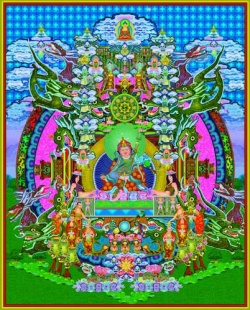Niramisa Sutta
{{Centre|{{Big2x|Niramisa Sutta: Unworldly
translated from the Pali by
Nyanaponika Thera
"There is, O monks, worldly joy,[1] there is unworldly joy, and there is a still greater unworldly joy. There is worldly happiness,[2] there is unworldly happiness, and there is a still greater unworldly happiness. There is worldly equanimity, there is unworldly equanimity, and there a still greater unworldly equanimity. There is worldly freedom, there is unworldly freedom, and there is a still greater unworldly freedom.
"Now, O monks, what is worldly joy? There are these five cords of sense desire: forms cognizable by the eye that are wished for and desired, agreeable and endearing, associated with sense-desire and tempting to lust. Sounds cognizable by the ear... odors cognizable by the nose... flavors cognizable by the tongue... tangibles cognizable by the body, wished for and desired, agreeable and endearing, associated with sense-desire and tempting to lust. It is the joy that arises dependent on these five cords of sense desire which is called 'worldly joy.'
"Now what is unworldly joy? Quite secluded from sense desires, secluded from unwholesome states of mind, a monk enters upon and abides in the first meditative absorption,[3] which is accompanied by thought-conception and discursive thinking, and has joy and happiness born of seclusion. With the stilling of thought-conception and discursive thinking, he enters upon and abides in the second meditative absorption which has internal confidence and singleness of mind without thought conception and discursive thinking, and has joy and happiness born of concentration. This is called 'unworldly joy.'
"And what is the still greater unworldly joy? When a taint-free monk looks upon his mind that is freed of greed, freed of hatred, freed of delusion, then there arises joy. This called a 'still greater unworldly joy.'
"Now, O monks, what is worldly happiness? There are these five cords of sense desire: forms cognizable by the eye... sounds cognizable by the ear... odors cognizable by the nose... flavors cognizable by the tongue... tangibles cognizable by the body that are wished for and desired, agreeable and endearing, associated with sense desire and alluring. It is the happiness and gladness that arises dependent on these five cords of sense desire which are called 'worldly happiness.'
"Now what is unworldly happiness? Quite secluded from sense desires, secluded from unwholesome states of mind, a monk enters upon and abides in the first meditative absorption... With the stilling of thought-conception and discursive thinking, he enters upon and abides in the second meditative absorption... With the fading away of joy as well, he dwells in equanimity, mindfully and fully aware he feels happiness within, and enters upon and abides in the third meditative absorption of which the Noble Ones announce: 'He dwells in happiness who has equanimity and is mindful.' This is called 'unworldly happiness.'
"And what is the still greater unworldly happiness? When a taint-free monk looks upon his mind that is freed of greed, freed of hatred, freed of delusion, then there arises happiness. This is called a 'still greater unworldly happiness.'
"Now, O monks, what is worldly equanimity? There are these five cords of sensual desire: forms cognizable by the eye... tangibles cognizable by the body that are wished for and desired, agreeable and endearing, associated with sense desire and alluring. It is the equanimity that arises with regard to these five cords of sense desire which is called 'worldly equanimity.'
"Now, what is unworldy equanimity? With the abandoning of pleasure and pain, and with the previous disappearance of gladness and sadness, a monk enters upon and abides in the fourth meditative absorption, which has neither pain-nor-pleasure and has purity of mindfulness due to equanimity. This is called 'unworldly equanimity.'
"And what is the still greater unworldly equanimity? When a taint-free monk looks upon his mind that is freed of greed, freed of hatred and freed of delusion, then there arises equanimity. This is called a 'still greater unworldly equanimity.'
"Now, O monks, what is worldly freedom? The freedom connected with the material. What is unworldly freedom? The freedom connected with the immaterial. And what is the still greater unworldly freedom? When a taint-free monk looks upon his mind that is freed of greed, freed of hatred, and freed of delusion, then there arises freedom."
Notes
1. piti.
2. sukha.
3. jhana.
